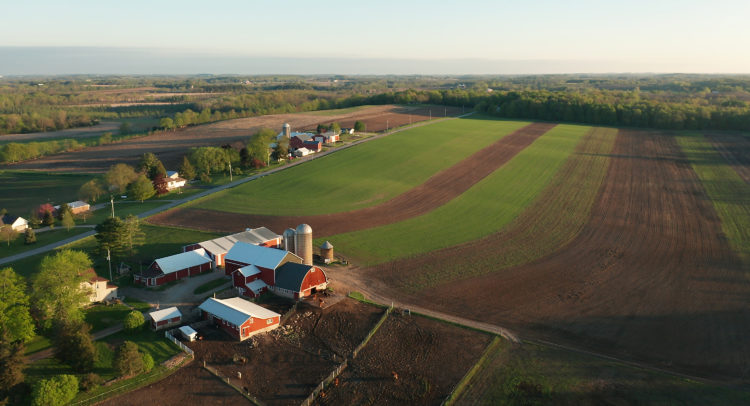Farmland has long been regarded as a valuable asset, both for its ability to produce food and as a potential investment. With the global population expected to continue growing, the demand for food is set to keep increasing over time.
Farmland also harbors several qualities due to food’s essential nature, especially since the availability of crops has been disputed following the war in Ukraine, which is one of the major produce exporters. Overall, due to its critical nature, the value of farmland is quite durable, and it even gradually appreciates over time, which makes it a great asset to hold for capital preservation.
Gladstone Land Corporation (NASDAQ: LAND) and Farmland Partners (NYSE: FPI) are the only two pure farmland plays that are publically traded. With uncertainty in the markets still fuming, investing in these two stocks could be an excellent way to preserve your capital and, in the meantime, enjoy a predictable stream of dividends.
In this article, I will discuss why Gladstone Land and Farmland Partners could be fitting investments for the current market environment, including their capacity to act as an inflation hedge and their tendency to generate low-volatility returns.
Farmland is a Hedge Against Inflation
Gladstone Land and Farmland Partners can be an excellent hedge against inflation. This is a great advantage to boast these days as inflation remains quite elevated, even if it has somewhat eased lately. Their inflation-hedge quality is due to several reasons.
First, the prices of agricultural commodities tend to increase with inflation. As the cost of producing these goods goes up, the prices that farmers can charge for their crops also increase. This means that the value of farmland, which is utilized to produce these crops, increases with inflation.
Farmland is also a tangible asset, and tangible asset values often rise in line with inflation. This is because as the purchasing power of money declines, investors will look for assets that are likely to retain their value in order to protect their wealth. With Gladstone Land and Farmland Partners owning such physical assets, their stock prices should not experience the same volatility as other financial assets.
To give you a frame of reference, from 1980 through 2021, the Fresh Fruits & Vegetables segment of the Food & Beverages category rose by 345%, which was 1.6x more than the gain in the overall Annual Food & Beverages CPI over the same period. Not only does this greatly illustrate that farmland can be a great inflation hedge, but the fact this data spans more than 40 years solidifies the validity of this argument.
The Key to Low-Volatility Returns
Due to their unique characteristics, including their nature as an inflation hedge, Gladstone Land and Farmland Partners can provide low-volatility returns and predictable dividend streams over the long run.
In fact, U.S. farmland has experienced lower volatility than both the S&P 500 (SPX) and the MSCI U.S. REIT Index while also exhibiting a low correlation to other major asset classes. To provide some background, the standard deviation of 20-year returns between 2002 and 2021 in the farmland index was 7.4% against the S&P 500’s 17.1% and the MSCI U.S. REIT Index’s 19.9%. Thus, farmland stocks can be great investment vehicles for generating low-volatility returns.
In that respect, both Gladstone Land’s and Farmland Partners’ dividends are well covered and should provide a predictable stream of income for investors, further enhancing the case for low-volatility returns. Farmland Partners is expected to generate FFO/share (funds from operations per share, an earnings metric used by REITs) of $0.32 for the year, covering its $0.24 annual dividend comfortably.
Gladstone Land is expected to deliver FFO/share of $0.74, also covering its $0.55 annual dividend quite sufficiently. Additionally, it’s worth noting that Gladstone Land’s dividends are paid monthly, adding to the predictability of the stock’s total returns.
Is LAND Stock a Buy, According to Analysts?
Turning to Wall Street, Gladstone Land has a Strong Buy consensus rating based on three Buys and one Hold assigned in the past three months. At $27.25, the average Gladstone Land price target implies 44.4% upside potential.

Is FPI Stock a Buy, According to Analysts?
As far as Farmland Partners goes, the stock has a Hold consensus rating based on two unanimous Holds assigned in the past three months. At $14.25, the average Farmland Partners price target implies 13.9% upside potential.

Takeaway – Great for Capital Preservation, but Expect Thin Returns
Gladstone Land and Farmland Partners should serve well those looking to preserve their capital via holding stocks that own tangible assets that appreciate in value over time. They can be ideal low-volatility holdings during the current uncertain environment.
Nevertheless, I would have minor return expectations ahead. Gladstone Land and Farmland Partners yield as little as 2.9% and 1.9%, while earnings and dividends are likely to grow negligibly over the long term. Farmland benefits during inflationary periods, and its value appreciates over the long run. However, this is a mature industry with no outer growth factors.
Due to their unique qualities, investors also tend to overvalue these assets. Gladstone Land and Farmland Partners trade at ~25.5x and ~40.0x their projected FFOs for the year. Their rich valuations could also limit investors’ future total returns.

